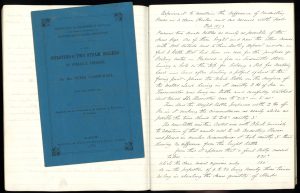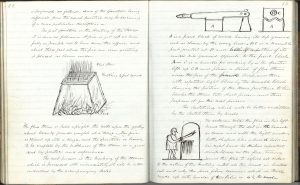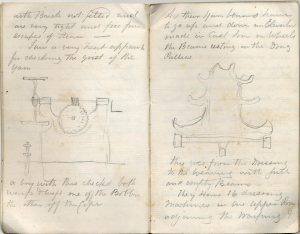The year 1846 was key to Carmichael’s career and was the beginnings of his renown as an inventor. In 1846, Carmichael was a manager within the Baxter Brothers Company. He was the superintendent of mills in both Dundee and Glamis.[i] The mill in Glamis drastically differed in production capabilities from those in Dundee. It was powered by a watermill and could produce two thousand spindles of yarn per week. In contrast, the Dens mills were powered by several steam engines which required much more careful monitoring from Carmichael. The Upper Dens mill consisted of eleven thousand spindles which were powered by the steam engines. This mill would produce 26,000 spindles of yarn per week.[ii]


Carmichael was well-liked and respected within the business. He ‘set a good example’ through displaying ‘punctuality, diligence and thrift’.[iii] He was characterised as ‘sympathetic’ to the men, women and children under his employment.
‘If the hand with which Mr Carmichael ruled over all was an iron hand, it was sheathed in a velvet glove.’[iv]
Carmichael closely monitored the functioning of the steam engines, performing weekly reviews and commissioning regular diagrams to show their workings – monitoring the coal consumption of each machine. His methodical and frugal running of the mills earned him the further respect of William Baxter.

On the 5th May, Carmichael took out a patent on a hackling machine and a rubbing machine. And later that year, on the 2nd October he – alongside his former mentor, Sir Peter Fairbairn of Leeds – took out a patent for making improvements upon machinery to help speed up the productivity of the mills.[v] Many manufacturers switched immediately to Carmichael’s machines and methods, and so catapulted him into a revered position in the manufacturing industry.[vi] The hackling machine, in particular, could operate without constant manual labour, reducing the costs of hired labour. While in the testing phase for the hackling machine, Carmichael wrote to his brother James, stating:
“The Hackling machine has every appearance of taking the lead & superseding all others. Marsden has more orders than he can execute, & where they have been started, they are doing beyond expectation.”[vii]
Some of Carmichael’s inventions were exported to Europe under high demand. The Baxter Brothers’ Company owned shares in several flax mills abroad. Carmichael’s inventions were exported to Ailly, among other places, which helped boost his reputation even further.[viii]
Overall, manufacturers greatly benefitted from Carmichael’s inventions. However there were some caveats, one of which was that the introduction of these machines left many without work. So, while Carmichael was hailed and celebrated among the mill owners, his inventions left the working class at a disadvantage. There had been some examples of ‘attacks’ on some machines within factories in large cities such as Manchester in the early 19th century.[ix] Some associated this with the relatively slow introduction to similar machinery to Dundee. The rise in the use of machinery, and ultimately the wealth of manufacturers, contributed to the financial difficulties faced by many among the working class in the nineteenth century.
[i] Ms102/1/2 Peter Carmichael: Life and Letters, Chapter 3 Dens Works and Inventions, 1846
[ii] Ibid
[iii] Ibid
[iv] Ibid
[v] Lenman, B., Blythe, C., Gauldie, E., (1969) The Dundee Textile Industry 1850-1914, The Abertay Historical Society Publication No. 14, <https://abertay.org.uk/wp-content/uploads/2017/08/dundee_textile_industry.pdf> [accessed 19 November 2020]
[vi] Ibid
[vii] Ms102/1/2 Peter Carmichael: Life and Letters, Chapter 3 Dens Works and Inventions, 1846
[viii] Lenman, B., Blythe, C., Gauldie, E., (1969) The Dundee Textile Industry 1850-1914, The Abertay Historical Society Publication No. 14, <https://abertay.org.uk/wp-content/uploads/2017/08/dundee_textile_industry.pdf> [accessed 19 November 2020]
[ix] Ms102/1/1/7 Reminiscences of Peter Carmichael, pg. 253
